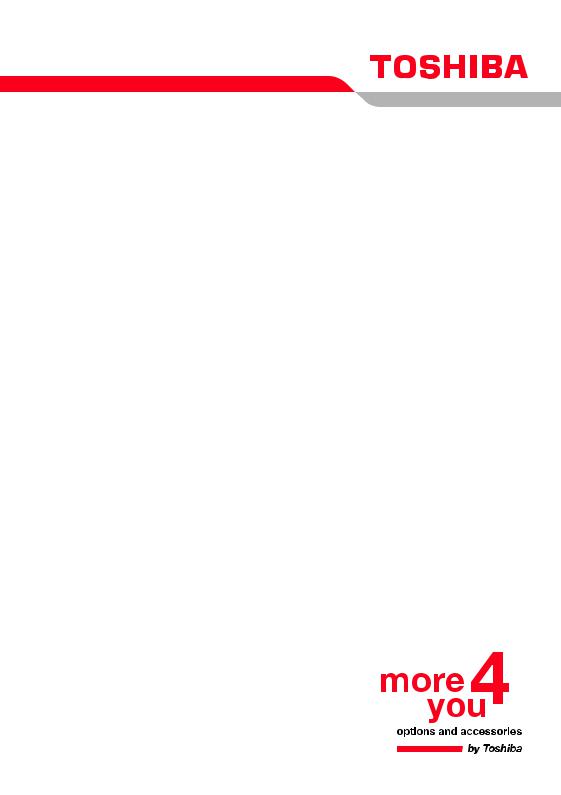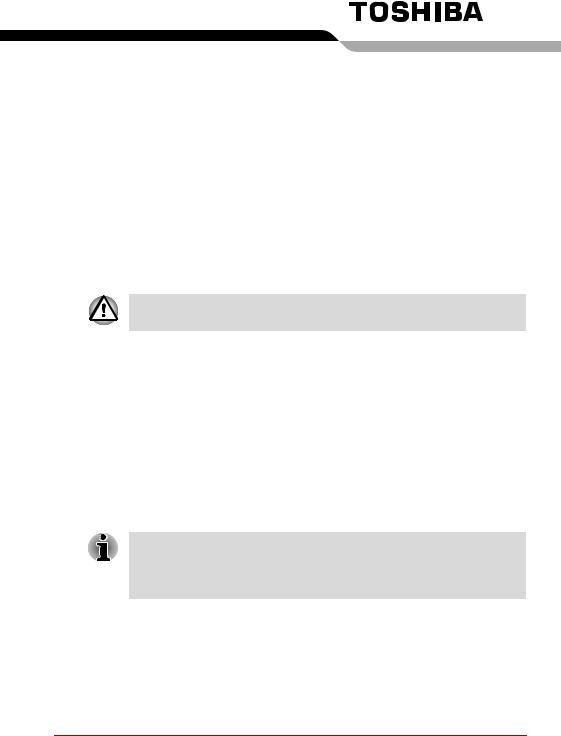Toshiba M400 User Manual

User’s Manual
PORTÉGÉ M400
Choose freedom.
computers.toshiba-europe.com

PORTÉGÉ M400
Copyright
© 2006 by TOSHIBA Corporation. All rights reserved. Under the copyright laws, this manual cannot be reproduced in any form without the prior written permission of TOSHIBA. No patent liability is assumed, with respect to the use of the information contained herein.
TOSHIBA PORTÉGÉ M400 Portable Personal Computer User’s Manual First edition February 2006
Copyright authority for music, movies, computer programs, data bases and other intellectual property covered by copyright laws belongs to the author or to the copyright owner. Copyrighted material can be reproduced only for personal use or use within the home. Any other use beyond that stipulated above (including conversion to digital format, alteration, transfer of copied material and distribution on a network) without the permission of the copyright owner is a violation of copyright or author’s rights and is subject to civil damages or criminal action. Please comply with copyright laws in making any reproduction from this manual.
Disclaimer
This manual has been validated and reviewed for accuracy. The instructions and descriptions it contains are accurate for the TOSHIBA PORTÉGÉ M400 Portable Personal Computer at the time of this manual’s production. However, succeeding computers and manuals are subject to change without notice. TOSHIBA assumes no liability for damages incurred directly or indirectly from errors, omissions or discrepancies between the computer and the manual.
Trademarks
IBM is a registered trademark and IBM PC is a trademark of International Business Machines Corporation.
Intel, Intel SpeedStep, Intel Core and Centrino are trademarks or registered trademarks of Intel Corporation.
Windows and Microsoft are registered trademarks of Microsoft Corporation. Photo CD is a trademark of Eastman Kodak.
Sonic RecordNow! is a registered trademark of Sonic Solutions.
Bluetooth is a trademark owned by its proprietor and used by TOSHIBA under license.
i.LINK is trademark and registered trademark of Sony Corporation.
InterVideo and WinDVD are registered trademarks of InterVideo Inc. WinDVD Creator is trademark of InterVideo Inc.
Other trademarks and registered trademarks not listed above may be used in this manual.
User’s Manual |
ii |

PORTÉGÉ M400
EU Declaration of Conformity
This product is labelled with the CE Mark in accordance with the related European Directives, notably Electromagnetic Compatibility Directive 89/336/EEC for the notebook and the electronic accessories including the supplied power adapter, the Radio Equipment and Telecommunications Terminal Equipment Directive 99/5/EC in case of implemented telecommunication accessories and the Low Voltage Directive 73/23/EEC for the supplied power adapter.
CE Marking is the responsibility of TOSHIBA EUROPE GmbH, Hammfelddamm 8,
41460 Neuss, Germany, phone +49-(0)-2131-158-01.
For a copy of the related CE Declaration of Conformity please refer to the following website: http://epps.toshiba-teg.com.
This product and the supplied accessories are designed to observe the related EMC (Electromagnetic Compatibility) and safety standards. However, TOSHIBA cannot guarantee that this product still observes these EMC standards if accessories or cables not manufactured / distributed by TOSHIBA are connected or implemented. To avoid EMC problems in general, the following advice should be observed:
■Only CE marked accessories should be connected / implemented.
■Only best shielded cables should be connected.
Working environment
This product was designed to fulfill the EMC (Electromagnetic Compatibility) requirements for "residential, commercial and light industry environments".
The following environments are not approved:
■Industrial Environments (e.g. environments with a mains voltage of 380V).
In the following environments the use of this product can be restricted:
■Medical Environments: This product is not certified as a medical product according to the Medical Product Directive 93/42/EEC, but can be used in office areas where the use is not restricted. Please disable the wireless LAN or Bluetooth hardware in such areas as long this feature is not official supported by the operator of the related medical facility.
■Vehicle Environments: Please read the operator’s manual of the vehicle manufacturer for further restrictions of use.
■Aircraft Environments: Please follow the advice of the flight personnel regarding restrictions of use.
User’s Manual |
iii |

PORTÉGÉ M400
Any consequences resulting from the use of this product in working environments that are not approved or the use is restricted are not the responsibility of TOSHIBA Corporation. The consequences of the use of this product in those working environments may be:
■Interference with other devices or machines in the nearby surrounding area
■Malfunction of or data loss from this product caused by disturbances generated by other devices or machines in the nearby surrounding area
Furthermore, for general safety reasons, the use of this product in environments with explosive atmospheres is not permitted.
Modem warning notice
Conformity Statement
The equipment has been approved to [Commission Decision "CTR21"] for pan-European single terminal connection to the Public Switched Telephone Network (PSTN).
However, due to differences between the individual PSTNs provided in different countries/regions the approval does not, of itself, give an unconditional assurance of successful operation on every PSTN network termination point.
In the event of problems, you should contact your equipment supplier in the first instance.
Network Compatibility Statement
This product is designed to work with, and is compatible with the following networks. It has been tested to and found to conform with the additional requirements conditional in EG 201 121.
Germany |
ATAAB AN005,AN006,AN007,AN009,AN010 and |
|
DE03,04,05,08,09,12,14,17 |
Greece |
ATAAB AN005,AN006 and GR01,02,03,04 |
Portugal |
ATAAB AN001,005,006,007,011 and |
|
P03,04,08,10 |
Spain |
ATAAB AN005,007,012, and ES01 |
Switzerland |
ATAAB AN002 |
All other |
ATAAB AN003,004 |
countries/regions |
|
Specific switch settings or software setup are required for each network, please refer to the relevant sections of the user guide for more details.
The hookflash (timed break register recall) function is subject to separate national type approvals. It has not been tested for conformity to national type regulations, and no guarantee of successful operation of that specific function on specific national networks can be given.
User’s Manual |
iv |

PORTÉGÉ M400
Description on Laser specification
The optical drive, such as a DVD-ROM / CD-R/RW drive or DVD Super Multi drive, that is used in this computer is equipped with a laser device. A classification label with the following sentence is affixed to the surface of the drive.
CLASS 1 LASER PRODUCT LASER KLASSE 1 LUOKAN 1 LASERLAITE
APPAREIL A LASER DE CLASSE 1 KLASS 1 LASER APPARAT
The drive with the above label is certified by the manufacturer that the drive complies with the requirement for laser product on the date of manufacturing pursuant to article 21 of Code of Federal Regulations by the United States of America, Department of Health & Human Services, Food and Drug Administration.
In other countries, the drive is certified to comply with the requirement pursuant to IEC 825 and EN60825 on class 1 laser product.
Depending on model, this computer is equipped with one of the optical drives from the following list:
Manufacturer |
Type |
|
|
MATSUSHITA |
UJDA765 |
|
|
MATSUSHITA |
UJ-822 |
|
|
MATSUSHITA |
UJ-842 |
|
|
User’s Manual |
v |

Preface
Congratulations on your purchase of the PORTÉGÉ M400 computer. This powerful notebook computer provides excellent expansion capability, including multimedia devices, and it is designed to provide years of reliable, high-performance computing.
This manual tells how to set up and begin using your PORTÉGÉ M400 computer. It also provides detailed information on configuring your computer, basic operations and care, using optional devices and troubleshooting.
If you are a new user of computers or if you’re new to portable computing, first read over the Introduction and The Grand Tour chapters to familiarize yourself with the computer’s features, components and accessory devices. Then read Getting Started for step-by-step instructions on setting up your computer.
If you are an experienced computer user, please continue reading the preface to learn how this manual is organized, then become acquainted with this manual by browsing through its pages. Be sure to look over the Special features section of the Introduction, to learn about features that are uncommon or unique to the computer and carefully read HW Setup.
If you are going to install PC cards or connect external devices such as a monitor, be sure to read Chapter 8, Optional Devices.
User’s Manual |
vi |

PORTÉGÉ M400
Manual contents
This manual is made up of the following.
Chapter 1, Introduction, is an overview of the computer’s features, capabilities, and options.
Chapter 2, The Grand Tour, identifies the components of the computer and briefly explains how they function.
Chapter 3, Getting Started, provides a quick overview of how to begin operating your computer and gives tips on safety and designing your work area.
Chapter 4, Operating Basics, This chapter describes the basic operations of your computer and precautions when using it, as well as the handling of CD/DVD.
Chapter 5, The Keyboard, describes special keyboard functions including the keypad overlay and hot keys.
Chapter 6, Power and Power-Up Modes, gives details on the computer’s power resources and battery save modes and how to set a password.
Chapter 7, HW Setup, explains how to configure the computer using the HW Setup program and TPM.
Chapter 8, Optional Devices, describes the optional hardware available.
Chapter 9, Troubleshooting, provides helpful information on how to perform some diagnostic tests, and suggests courses of action if the computer doesn’t seem to be working properly.
Chapter 10, Legal Footnotes, provides Legal Footnotes information related to your computer.
The Appendixes provide technical information about your computer.
The Glossary defines general computer terminology and includes a list of acronyms used in the text.
The Index quickly directs you to the information contained in this manual.
Conventions
This manual uses the following formats to describe, identify, and highlight terms and operating procedures.
Abbreviations
On first appearance, and whenever necessary for clarity, abbreviations are enclosed in parentheses following their definition. For example: Read Only Memory (ROM). Acronyms are also defined in the Glossary.
Icons
Icons identify ports, dials, and other parts of your computer. The indicator panel also uses icons to identify the components it is providing information on.
User’s Manual |
vii |

PORTÉGÉ M400
Keys
The keyboard keys are used in the text to describe many computer operations. A distinctive typeface identifies the key top symbols as they appear on the keyboard. For example, Enter identifies the Enter key.
Key operation
Some operations require you to simultaneously use two or more keys. We identify such operations by the key top symbols separated by a plus sign
(+). For example, Ctrl + C means you must hold down Ctrl and at the same time press C. If three keys are used, hold down the first two and at the same time press the third.
ABC |
When procedures require an action such as |
|
clicking an icon or entering text, the icon’s name |
|
or the text you are to type in is represented in the |
|
type face you see to the left. |
Display |
|
S ABC |
Names of windows or icons or text generated by |
the computer that appear on its display screen |
|
|
are presented in the type face you see to the left. |
User’s Manual |
viii |

PORTÉGÉ M400
Messages
Messages are used in this manual to bring important information to your attention. Each type of message is identified as shown below.
Pay attention! A caution informs you that improper use of equipment or failure to follow instructions may cause data loss or damage your equipment.
Please read. A note is a hint or advice that helps you make best use of your equipment.
Indicates a potentially hazardous situation, which could result in death or serious injury, if you do not follow instructions.
User’s Manual |
ix |

PORTÉGÉ M400
User’s Manual |
x |

General Precautions
TOSHIBA computers are designed to optimize safety, minimize strain and withstand the rigors of portability. However, certain precautions should be observed to further reduce the risk of personal injury or damage to the computer.
Be certain to read the general precautions below and to note the cautions included in the text of the manual.
Stress injury
Carefully read the Instruction Manual for Safety & Comfort. It contains information on prevention of stress injuries to your hands and wrists than can be caused by extensive keyboard use. Chapter 3, Getting Started, also includes information on work space design, posture and lighting that can help reduce physical stress.
Heat injury
■Avoid prolonged physical contact with the computer. If the computer is used for long periods, its surface can become very warm. While the temperature will not feel hot to the touch, if you maintain physical contact with the computer for a long time (if you rest the computer on your lap, or if you keep your hands on the palm rest, for example) your skin might suffer low-heat injury.
■If the computer has been used for a long time, avoid direct contact with the metal plate supporting the I/O ports. It can become hot.
■The surface of the AC adaptor can become hot when in use. This condition does not indicate a malfunction. If you need to transport the AC adaptor, disconnect it and let it cool before moving it.
■Do not lay the AC adaptor on a material that is sensitive to heat. The material could be damaged.
User’s Manual |
xi |

PORTÉGÉ M400
Pressure or impact damage
Do not apply heavy pressure to the computer or subject it to strong impact. Excessive pressure or impact can cause damage to computer components or otherwise cause malfunctions.
PC card overheating
Some PC cards can become hot with prolonged use. Overheating of a PC card can result in errors or instability in the PC card operation. Also be careful when you remove a PC card that has been used for a long time.
Mobile phones
Use of mobile phones can interfere with the audio system. Computer operation is not impaired but it is recommended that a distance of 30 cm be maintained between the computer and a mobile phone in use.
User’s Manual |
xii |

Table of Contents
Preface
General Precautions
Chapter 1 Introduction
Equipment checklist. . . . . . . . . . . . . . . . . . . . . . . . . . . . . . . . . . . . . . . 1-1 Features. . . . . . . . . . . . . . . . . . . . . . . . . . . . . . . . . . . . . . . . . . . . . . . . . 1-3 Special features . . . . . . . . . . . . . . . . . . . . . . . . . . . . . . . . . . . . . . . . . 1-10 Utilities. . . . . . . . . . . . . . . . . . . . . . . . . . . . . . . . . . . . . . . . . . . . . . . . . 1-13 Options . . . . . . . . . . . . . . . . . . . . . . . . . . . . . . . . . . . . . . . . . . . . . . . . 1-17
Chapter 2 The Grand Tour
Front with the display closed . . . . . . . . . . . . . . . . . . . . . . . . . . . . . . . 2-1 Left side . . . . . . . . . . . . . . . . . . . . . . . . . . . . . . . . . . . . . . . . . . . . . . . . . 2-3 Right side . . . . . . . . . . . . . . . . . . . . . . . . . . . . . . . . . . . . . . . . . . . . . . . 2-4 Back side. . . . . . . . . . . . . . . . . . . . . . . . . . . . . . . . . . . . . . . . . . . . . . . . 2-5 Underside . . . . . . . . . . . . . . . . . . . . . . . . . . . . . . . . . . . . . . . . . . . . . . . 2-6 Front with the display open. . . . . . . . . . . . . . . . . . . . . . . . . . . . . . . . . 2-8 System indicators. . . . . . . . . . . . . . . . . . . . . . . . . . . . . . . . . . . . . . . . 2-11 Keyboard indicators. . . . . . . . . . . . . . . . . . . . . . . . . . . . . . . . . . . . . . 2-12 USB floppy disk drive (optional) . . . . . . . . . . . . . . . . . . . . . . . . . . . . 2-13 Optical media drives . . . . . . . . . . . . . . . . . . . . . . . . . . . . . . . . . . . . . 2-14 AC adaptor . . . . . . . . . . . . . . . . . . . . . . . . . . . . . . . . . . . . . . . . . . . . . 2-16
Chapter 3 Getting Started
Setting up your work space. . . . . . . . . . . . . . . . . . . . . . . . . . . . . . . . . 3-1 Operating the computer in Tablet mode. . . . . . . . . . . . . . . . . . . . . . . 3-6 Connecting the AC adaptor . . . . . . . . . . . . . . . . . . . . . . . . . . . . . . . . . 3-7 Opening the display . . . . . . . . . . . . . . . . . . . . . . . . . . . . . . . . . . . . . . 3-10 Turning on the power . . . . . . . . . . . . . . . . . . . . . . . . . . . . . . . . . . . . . 3-10 Starting up for the first time . . . . . . . . . . . . . . . . . . . . . . . . . . . . . . . 3-11 Turning off the power. . . . . . . . . . . . . . . . . . . . . . . . . . . . . . . . . . . . . 3-11 Restarting the computer . . . . . . . . . . . . . . . . . . . . . . . . . . . . . . . . . . 3-15 Restoring your preinstalled software . . . . . . . . . . . . . . . . . . . . . . . . 3-15
User’s Manual |
xiii |

PORTÉGÉ M400
Chapter 4 Operating Basics
Using the Touch Pad . . . . . . . . . . . . . . . . . . . . . . . . . . . . . . . . . . . . . . 4-1 Using the Tablet PC Pen and Reserve Pen . . . . . . . . . . . . . . . . . . . . 4-2 Changing to the Tablet mode . . . . . . . . . . . . . . . . . . . . . . . . . . . . . . . 4-8 Changing the screen orientation. . . . . . . . . . . . . . . . . . . . . . . . . . . . 4-10 Using Accelerometer Utilities . . . . . . . . . . . . . . . . . . . . . . . . . . . . . . 4-12 Changing to the laptop mode . . . . . . . . . . . . . . . . . . . . . . . . . . . . . . 4-13 Using the Fingerprint Sensor . . . . . . . . . . . . . . . . . . . . . . . . . . . . . . 4-13 Using the USB floppy disk drive (optional) . . . . . . . . . . . . . . . . . . . 4-20 Changing Ultra Slim Bay modules . . . . . . . . . . . . . . . . . . . . . . . . . . 4-21 Using optical media drives . . . . . . . . . . . . . . . . . . . . . . . . . . . . . . . . 4-23 Writing CDs on DVD-ROM / CD-R/RW drive . . . . . . . . . . . . . . . . . . . 4-27 Writing CD/DVDs on DVD Super Multi drive . . . . . . . . . . . . . . . . . . 4-29 Media care . . . . . . . . . . . . . . . . . . . . . . . . . . . . . . . . . . . . . . . . . . . . . . 4-38 Sound System. . . . . . . . . . . . . . . . . . . . . . . . . . . . . . . . . . . . . . . . . . . 4-39 Modem . . . . . . . . . . . . . . . . . . . . . . . . . . . . . . . . . . . . . . . . . . . . . . . . . 4-41 Wireless communications . . . . . . . . . . . . . . . . . . . . . . . . . . . . . . . . . 4-44 LAN . . . . . . . . . . . . . . . . . . . . . . . . . . . . . . . . . . . . . . . . . . . . . . . . . . . 4-48 Cleaning the computer. . . . . . . . . . . . . . . . . . . . . . . . . . . . . . . . . . . . 4-49 Moving the computer . . . . . . . . . . . . . . . . . . . . . . . . . . . . . . . . . . . . . 4-50 Using the Hard Disk Drive (HDD) Protection . . . . . . . . . . . . . . . . . . 4-51 Heat dispersal . . . . . . . . . . . . . . . . . . . . . . . . . . . . . . . . . . . . . . . . . . . 4-53
Chapter 5 The Keyboard
Typewriter keys. . . . . . . . . . . . . . . . . . . . . . . . . . . . . . . . . . . . . . . . . . . 5-1 Function keys: F1 … F12 . . . . . . . . . . . . . . . . . . . . . . . . . . . . . . . . . . . 5-2 Soft keys: Fn key combinations . . . . . . . . . . . . . . . . . . . . . . . . . . . . . 5-2 Hot keys. . . . . . . . . . . . . . . . . . . . . . . . . . . . . . . . . . . . . . . . . . . . . . . . . 5-3 Windows special keys . . . . . . . . . . . . . . . . . . . . . . . . . . . . . . . . . . . . . 5-7 Keypad overlay . . . . . . . . . . . . . . . . . . . . . . . . . . . . . . . . . . . . . . . . . . . 5-7 Generating ASCII characters. . . . . . . . . . . . . . . . . . . . . . . . . . . . . . . . 5-9
Chapter 6 Power and Power-Up Modes
Power conditions . . . . . . . . . . . . . . . . . . . . . . . . . . . . . . . . . . . . . . . . . 6-1 Power indicators. . . . . . . . . . . . . . . . . . . . . . . . . . . . . . . . . . . . . . . . . . 6-4 Battery types. . . . . . . . . . . . . . . . . . . . . . . . . . . . . . . . . . . . . . . . . . . . . 6-5 Care and use of the battery pack . . . . . . . . . . . . . . . . . . . . . . . . . . . . 6-7 Replacing the battery pack . . . . . . . . . . . . . . . . . . . . . . . . . . . . . . . . 6-14 TOSHIBA Password Utility. . . . . . . . . . . . . . . . . . . . . . . . . . . . . . . . . 6-16 Tablet mode. . . . . . . . . . . . . . . . . . . . . . . . . . . . . . . . . . . . . . . . . . . . . 6-19 Power-up modes. . . . . . . . . . . . . . . . . . . . . . . . . . . . . . . . . . . . . . . . . 6-19 Panel power on/off . . . . . . . . . . . . . . . . . . . . . . . . . . . . . . . . . . . . . . . 6-20 System Auto Off . . . . . . . . . . . . . . . . . . . . . . . . . . . . . . . . . . . . . . . . . 6-20
User’s Manual |
xiv |

PORTÉGÉ M400
Chapter 7 HW Setup
Accessing HW Setup . . . . . . . . . . . . . . . . . . . . . . . . . . . . . . . . . . . . . . 7-1 HW Setup window . . . . . . . . . . . . . . . . . . . . . . . . . . . . . . . . . . . . . . . . 7-1 Configuring the Execute-Disable Bit Capability and TPM . . . . . . . . 7-8
Chapter 8 Optional Devices
PC card . . . . . . . . . . . . . . . . . . . . . . . . . . . . . . . . . . . . . . . . . . . . . . . . . 8-2 Bridge media slot . . . . . . . . . . . . . . . . . . . . . . . . . . . . . . . . . . . . . . . . . 8-3 Memory expansion . . . . . . . . . . . . . . . . . . . . . . . . . . . . . . . . . . . . . . . . 8-9 Battery Pack . . . . . . . . . . . . . . . . . . . . . . . . . . . . . . . . . . . . . . . . . . . . 8-14 Universal AC Adaptor . . . . . . . . . . . . . . . . . . . . . . . . . . . . . . . . . . . . 8-14 Slice Expansion Battery. . . . . . . . . . . . . . . . . . . . . . . . . . . . . . . . . . . 8-15 Battery Charger . . . . . . . . . . . . . . . . . . . . . . . . . . . . . . . . . . . . . . . . . 8-17 HDD Kit (Serial-ATA). . . . . . . . . . . . . . . . . . . . . . . . . . . . . . . . . . . . . . 8-17 Ultra Slim Bay HDD Adaptor . . . . . . . . . . . . . . . . . . . . . . . . . . . . . . . 8-19 USB FDD Kit . . . . . . . . . . . . . . . . . . . . . . . . . . . . . . . . . . . . . . . . . . . . 8-20 Tablet PC Pen . . . . . . . . . . . . . . . . . . . . . . . . . . . . . . . . . . . . . . . . . . . 8-20 Reserve Pen . . . . . . . . . . . . . . . . . . . . . . . . . . . . . . . . . . . . . . . . . . . . 8-20 External monitor . . . . . . . . . . . . . . . . . . . . . . . . . . . . . . . . . . . . . . . . . 8-21 i.LINK (IEEE1394) . . . . . . . . . . . . . . . . . . . . . . . . . . . . . . . . . . . . . . . . 8-21 TOSHIBA Express Port Replicator . . . . . . . . . . . . . . . . . . . . . . . . . . 8-23 Security lock . . . . . . . . . . . . . . . . . . . . . . . . . . . . . . . . . . . . . . . . . . . . 8-24
Chapter 9 Troubleshooting
Problem solving process. . . . . . . . . . . . . . . . . . . . . . . . . . . . . . . . . . . 9-1 Hardware and system checklist . . . . . . . . . . . . . . . . . . . . . . . . . . . . . 9-3 TOSHIBA support . . . . . . . . . . . . . . . . . . . . . . . . . . . . . . . . . . . . . . . . 9-20
Chapter 10 Legal Footnotes
CPU*1. . . . . . . . . . . . . . . . . . . . . . . . . . . . . . . . . . . . . . . . . . . . . . . . . . 10-1 Memory (Main System)*2 . . . . . . . . . . . . . . . . . . . . . . . . . . . . . . . . . . 10-2 Battery Life*3 . . . . . . . . . . . . . . . . . . . . . . . . . . . . . . . . . . . . . . . . . . . 10-2 HDD Drive Capacity*4. . . . . . . . . . . . . . . . . . . . . . . . . . . . . . . . . . . . . 10-2 LCD*5. . . . . . . . . . . . . . . . . . . . . . . . . . . . . . . . . . . . . . . . . . . . . . . . . . 10-3 Graphics Processor Unit ("GPU")*6 . . . . . . . . . . . . . . . . . . . . . . . . . 10-3 Wireless LAN*7 . . . . . . . . . . . . . . . . . . . . . . . . . . . . . . . . . . . . . . . . . . 10-3 Non-applicable Icons*8 . . . . . . . . . . . . . . . . . . . . . . . . . . . . . . . . . . . 10-3 Copy Protection*9 . . . . . . . . . . . . . . . . . . . . . . . . . . . . . . . . . . . . . . . 10-3 Images*10 . . . . . . . . . . . . . . . . . . . . . . . . . . . . . . . . . . . . . . . . . . . . . . 10-3
Appendix A Specifications
Physical Dimensions . . . . . . . . . . . . . . . . . . . . . . . . . . . . . . . . . . . . . . A-1
Appendix B Display Controller and Modes
Display controller . . . . . . . . . . . . . . . . . . . . . . . . . . . . . . . . . . . . . . . . . B-1 Video modes . . . . . . . . . . . . . . . . . . . . . . . . . . . . . . . . . . . . . . . . . . . . . B-1
User’s Manual |
xv |

PORTÉGÉ M400
Appendix C Wireless LAN
Card Specifications . . . . . . . . . . . . . . . . . . . . . . . . . . . . . . . . . . . . . . . C-1 Radio Characteristics. . . . . . . . . . . . . . . . . . . . . . . . . . . . . . . . . . . . . . C-2 Supported Frequency Sub-bands. . . . . . . . . . . . . . . . . . . . . . . . . . . . C-2
Appendix D TOSHIBA RAID
Windows Manual Setup . . . . . . . . . . . . . . . . . . . . . . . . . . . . . . . . . . . . D-2 Starting, Modifying and Ending the BIOS Setup Program . . . . . . . . D-4
Appendix E Bluetooth wireless technology Interoperability
Bluetooth wireless technology and your Health . . . . . . . . . . . . . . . . E-3 Regulatory statements . . . . . . . . . . . . . . . . . . . . . . . . . . . . . . . . . . . . . E-3
Appendix F AC Power Cord and Connectors
Certification agencies . . . . . . . . . . . . . . . . . . . . . . . . . . . . . . . . . . . . . F-1
Appendix G TOSHIBA Anti-theft Protection Timer Appendix H If your computer is stolen
Glossary
Index
User’s Manual |
xvi |

Chapter 1
Introduction
This chapter provides an equipment checklist, and it identifies the computer’s features, options and accessories.
Some of the features described in this manual may not function properly if you use an operating system that was not preinstalled by TOSHIBA.
Equipment checklist
Carefully unpack your computer. Save the box and packing materials for future use.
Hardware
Check to make sure you have all the following items:
■PORTÉGÉ M400 Portable Personal Computer
■AC adaptor and power cord (2-pin plug or 3-pin plug)
■Tablet PC Pen
■Reserve Pen (Provided with some models)
■The Tablet PC Pen is included in the accessory tray of the product when purchased together with spare pen tips and a tip removal tool.
■For some models, a Reserve Pen is also included in the accessory tray of the product when purchased.
User’s Manual |
1-1 |

Introduction
Software
Microsoft ® Windows XP Tablet PC Edition
■The following software is preinstalled:
■Microsoft® Windows XP Tablet PC Edition
■Microsoft Internet Explorer
■TOSHIBA Utilities
■TOSHIBA SD Memory Boot Utility
■DVD Video Player
■TOSHIBA TouchPad On/Off Utility
■TOSHIBA Power Saver
■TOSHIBA Mobile Extension
■TOSHIBA Assist
■TOSHIBA ConfigFree
■TOSHIBA Zooming Utility
■TOSHIBA PC Diagnostic Tool
■TOSHIBA Controls
■TOSHIBA Mic Effect
■TOSHIBA Password Utility
■TOSHIBA Rotation Utility
■TOSHIBA Accelerometer Utilities
■TOSHIBA Tablet Access Code Logon Utility
■Fingerprint utility
■TOSHIBA Wireless Key Logon
■Online manual
■Product Recovery DVD-ROM
Documentation
■PORTÉGÉ M400 Portable Personal Computer User's Manual
■PORTÉGÉ M400 Quickstart
■Microsoft Windows XP Tablet PC Edition Getting Started manual
■Instruction Manual for Safety & Comfort
■Warranty information
If any of the items are missing or damaged, contact your dealer immediately.
User’s Manual |
1-2 |

Introduction
Features
The computer uses TOSHIBA’s advanced Large Scale Integration (LSI), Complementary Metal-Oxide Semiconductor (CMOS) technology extensively to provide compact size, minimum weight, low power usage, and high reliability. This computer incorporates the following features and benefits:
Processor
Built-in |
The computer is equipped with one of the |
|
following Intel® processors. |
|
Intel® Core™ Duo Processor, which incorporates |
|
a 2MB level2 cache memory. It also supports |
|
Enhanced Intel® SpeedStep® Technology. |
|
Intel® Core™ Solo Processor, which incorporates |
|
a 2MB level2 cache memory. It also supports |
|
Enhanced Intel® SpeedStep® Technology. |
Some models in the range are equipped with Intel® Centrino® Duo Mobile Technology, which is based on three separate technologies of Intel® Core™ Duo processor, Intel® PRO/Wireless Network Connection, and Mobile Intel® 945 Express Chipset Family.
In addition, some models in the range are equipped with Intel® Centrino® Mobile Technology, which is based on three separate technologies of Intel® Core™ Solo processor, Intel® PRO/Wireless Network Connection, and Mobile Intel® 945 Express Chipset Family.
Legal Footnote (CPU)*1
For more information on the Legal Footnote regarding CPU, please refer to the Legal Footnotes section in Chapter 10.
Memory
Slots |
256, 512, 1,024 or 2,048 MB memory modules |
|
can be installed in the two memory slots for a |
|
maximum of 4,096 MB system memory. |
|
|
Video RAM |
A maximum of 128 MB of RAM is provided for |
|
video display, with part of the main system |
|
memory being used for Video RAM. |
|
|
Legal Footnote (Memory (Main System))*2
For more information on the Legal Footnote regarding Memory
(Main System), please refer to the Legal Footnotes section in Chapter 10.
User’s Manual |
1-3 |

|
|
Introduction |
|
Power |
|
|
|
|
|
Battery pack |
The computer is powered by one rechargeable |
|
|
lithium-ion battery pack. |
|
|
|
|
|
|
|
Slice Expansion |
This battery pack increases your computer's |
|
Battery |
operating time when main battery pack is also |
|
|
installed. |
|
|
|
Legal Footnote (Battery Life)*3
For more information on the Legal Footnote regarding Battery Life, please refer to the Legal Footnotes section in Chapter 10.
RTC battery |
The internal RTC battery backs up the Real Time |
|
Clock (RTC) and calendar. |
|
|
AC adaptor |
The AC adaptor provides power to the system |
|
and recharges the batteries when they are low. |
|
It comes with a detachable power cord which will |
|
either have a 2-pin or 3-pin plug enclosure. |
|
Because it is universal, it can receive a range of |
|
AC voltage from 100 to 240 volts; however, the |
|
output current varies among different models. |
|
Using the wrong model can damage your |
|
computer. Refer to the AC adaptor section in |
|
Chapter 2, The Grand Tour. |
|
|
Disks |
|
|
|
Hard disk drive |
Available in five sizes. |
|
■ 40.0 billion bytes (37.26 GB) |
|
■ 60.0 billion bytes (55.89 GB) |
|
■ 80.0 billion bytes (74.53 GB) |
|
■ 100.0 billion bytes (93.16 GB) |
|
■ 120.0 billion bytes (111.79 GB) |
|
Part of the space in the hard disk drive is |
|
reserved as administration space. |
|
|
Legal Footnote (Hard Disk Drive Capacity)*4
For more information on the Legal Footnote regarding HDD Drive Capacity, please refer to the Legal Footnotes section in Chapter 10.
User’s Manual |
1-4 |

Introduction
Optical media drive
Computers in this series can be configured with an optical media drive installed in the Ultra Slim Bay. The available optical media drives are described below.
DVD-ROM / CD-R/RW Some models are equipped with a full-size,
drive |
DVD-ROM / CD-R/RW drive module that lets you |
|
run CD/DVDs without using an adaptor. It reads |
|
DVD-ROMs at maximum 8 speed and CD-ROMs |
|
at maximum 24 speed. It writes CD-Rs at |
|
maximum 24 speed and CD-RWs at maximum |
|
24 speed. The drive supports the following |
|
formats: |
|
■ CD-R |
|
■ CD-RW |
|
■ DVD-ROM |
|
■ DVD-Video |
|
■ CD-DA |
|
■ CD-Text |
|
■ Photo CD™ (single/multi-session) |
|
■ CD-ROM Mode 1, Mode 2 |
|
■ CD-ROM XA Mode 2 (Form1, Form2) |
|
■ Enhanced CD (CD-EXTRA) |
|
■ Addressing Method 2 |
DVD Super Multi Some models are equipped with a full-size DVD drive Super Multi drive module that lets you record
data to rewritable CD/DVDs as well as run either 12cm (4.72") or 8cm (3.15") CD/DVDs without using an adaptor. It reads DVD-ROMs at maximum 8 speed and CD-ROMs at maximum 24 speed. It writes CD-Rs at maximum 24 speed, CD-RWs at maximum 10 speed, DVD-Rs and DVD-RWs at maximum 2 speed, DVD+Rs and DVD+RWs at maximum 2.4 speed and DVD-RAM at maximum 2 speed. This drive supports the following formats in addition to the DVD-ROM / CD-R/RW drive.
■DVD-R
■DVD-RW
■DVD+R
■DVD+RW
■DVD-RAM
User’s Manual |
1-5 |

Introduction
DVD Super Multi This computer is equipped with a full-size DVD drive Double Layer Super Multi drive module that lets you record
data to rewritable CD/DVDs as well as run 12cm (4.72") or 8cm (3.15") CD/DVDs. It reads DVD-ROMs at maximum 8 speed and CD-ROMs at maximum 24 speed. It writes CD-Rs at up to 24 speed, CD-RWs at up to 16 speed, DVD-Rs and DVD+Rs at up to 8 speed, DVD-RWs and DVD+RWs at up to 4 speed, DVD-R DL at up to 2 speed, DVD+R DL at up to 2.4 speed and DVD-RAM at maximum 3 speed. This drive supports the following formats in addition to the DVD Super Multi drive.
■DVD+R DL
■DVD-R DL
Display
The computer’s LCD display panel supports high-resolution video graphics. The LCD screen can be set at a wide range of viewing angles for maximum comfort and readability.
Built-in |
12.1" TFT LCD screen, 16 million colors, with |
|
|
one of the following resolutions: |
|
|
■ |
XGA, 1024 horizontal × 768 vertical pixels |
|
■ |
SXGA+, 1400 horizontal × 1050 vertical |
|
|
pixels |
|
|
|
Legal Footnote (LCD)*5
For more information on the Legal Footnote regarding LCD, please refer to the Legal Footnotes section in Chapter 10.
Graphics controller The graphics controller maximizes display performance. Refer to Display Controller and Modes section in Appendix B for more information.
Legal Footnote (Graphics Processor Unit ("GPU"))*6
For more information on the Legal Footnote regarding Graphics Processor Unit ("GPU"), please refer to the Legal Footnotes section in Chapter 10.
Keyboard
Built-in |
84 keys or 85 keys, compatible with IBM® |
|
enhanced keyboard, embedded numeric overlay, |
|
dedicated cursor control, and keys. |
|
Refer to Chapter 5, The Keyboard, for details. |
|
|
User’s Manual |
1-6 |

|
|
Introduction |
|
Pointing Device |
|
|
|
|
|
Built-in Touch Pad |
A Touch Pad and control buttons in the palm rest |
|
|
enable control of the on-screen pointer and |
|
|
scrolling of windows. |
|
|
|
|
Tablet PC Pen |
A pen enables data entry directly through the |
|
|
display screen. |
|
|
|
|
Reserve Pen |
Some models in the range include a separate |
|
|
Reserve Pen which can be used for data entry in |
|
|
the event that the main Tablet PC Pen is lost or |
|
|
damaged. |
|
|
|
|
Ports |
|
|
|
|
|
External monitor |
Analog VGA port supports VESA DDC2B |
|
|
compatible functions. |
|
|
|
|
Universal Serial Bus |
The computer has Universal Serial Bus ports that |
|
(USB 2.0) |
comply with the USB 2.0 standard. |
|
|
|
|
Docking |
This port enables connection of an optional |
|
|
TOSHIBA Express Port Replicator described in |
|
|
the Options section. |
|
|
|
|
i.LINK™ (IEEE 1394) |
This port enables high-speed data transfer |
|
|
directly from external devices such as digital |
|
|
video cameras. |
|
|
|
|
Slots |
|
|
|
|
|
PC card |
The PC card slot accommodates a Type II card. |
|
|
|
|
Bridge media |
This slot lets you insert SD card, Memory Stick |
|
|
(Pro), xD picture card and SDIO card devices. |
|
|
Refer to Chapter 8, Optional Devices. |
|
|
|
|
Multimedia |
|
|
|
|
|
Sound system |
The Windows sound system compatible sound |
|
|
system provides output to internal speakers and |
|
|
input from two internal microphones as well as |
|
|
supports jacks for an external microphone and |
|
|
headphones. |
|
|
|
|
Headphone jack |
A 3.5 mm mini headphone jack enables |
|
|
connection of stereo headphones. |
|
|
|
|
Microphone jack |
A 3.5 mm mini microphone jack enables |
|
|
connection of a three-conductor mini jack for |
|
|
monaural microphone input. |
|
|
|
User’s Manual |
1-7 |

|
|
Introduction |
|
Communications |
|
|
|
|
|
Modem |
An internal modem provides capability for data |
|
|
and fax communication. It supports V.90 (V.92). |
|
|
The speed of data transfer and fax depends on |
|
|
analog telephone line conditions. It has a modem |
|
|
jack for connecting to a telephone line. Both of |
|
|
V.90 and V.92 are supported only in USA, |
|
|
Canada, UK, France, Germany and Australia. |
|
|
Only V.90 is available in other regions. |
|
|
|
|
LAN |
The computer has built-in support for Ethernet |
|
|
LAN (10 megabits per second, 10BASE-T), |
|
|
Fast Ethernet LAN (100 megabits per second, |
|
|
100BASE-TX) and Gigabit Ethernet LAN |
|
|
(1000 megabits per second, 1000BASE-T). |
|
|
|
|
Bluetooth |
Some computers in this series are equipped with |
|
|
Bluetooth functions. Bluetooth wireless |
|
|
technology eliminates the need for cables |
|
|
between electronic devices such as computers |
|
|
and printers. Bluetooth provides fast, reliable, |
|
|
and secure wireless communication in a small |
|
|
space. |
|
|
|
|
Wireless LAN |
Some computers in this series are equipped with |
|
|
a Wireless LAN card that is compatible with other |
|
|
LAN systems based on Direct Sequence Spread |
|
|
Spectrum/Orthogonal Frequency Division |
|
|
Multiplexing radio technology that complies with |
|
|
the IEEE 802.11 Standard (Revision A, B or G). |
|
|
■ Theoretical maximum speed: 54Mbps |
|
|
(IEEE802.11a, 802.11g). |
|
|
■ Theoretical maximum speed: 11Mbps |
|
|
(IEEE802.11b). |
|
|
■ Frequency Channel Selection (5 GHz: |
|
|
Revision A / 2.4 GHz: Revision B/G). |
|
|
■ Roaming over multiple channels. |
|
|
■ Card Power Management. |
|
|
■ Wired Equivalent Privacy (WEP) data |
|
|
encryption, based on 128 bit encryption |
|
|
algorithm. |
|
|
■ Wi-Fi Protected Access (WPA). |
|
|
■ Advanced Encryption Standard (AES) data |
|
|
encryption. |
|
|
■ Wake-up on Wireless LAN. |
|
|
|
User’s Manual |
1-8 |

Introduction
■The values shown above are the theoretical maximums for Wireless LAN standards. The actual values may differ.
■The transmission speed over the Wireless LAN and the distance over which Wireless LAN can reach may vary depending on surrounding electromagnetic environment, obstacles, access point design and configuration, and client design and software/hardware configurations. The transmission rate described is the theoretical maximum speed as specified under the appropriate standard - the actual transmission speed will be lower than the theoretical maximum speed.
Legal Footnote (Wireless LAN)*7
For more information on the Legal Footnote regarding Wireless LAN, please refer to the Legal Footnotes section in Chapter 10.
Wireless |
This switch turns the Wireless LAN and |
communication |
Bluetooth functions on and off. |
switch |
|
|
|
Ultra Slim Bay |
|
|
|
Ultra Slim Bay |
The Ultra Slim Bay is a single-drive bay that |
Modules |
accommodates either a DVD-ROM / CD-R/RW |
|
drive, DVD Super Multi drive or a secondary hard |
|
disk drive. The TOSHIBA Mobile Extension utility |
|
enables the hot insertion of these modules when |
|
you are using a plug and play operating system. |
|
|
Security |
|
|
|
Security lock slot |
Allows the connection of a security lock to anchor |
|
the computer to a desk or other large object. |
|
|
Ultra Slim Bay latch |
The Ultra Slim Bay module is secured into the |
|
computer when the Ultra Slim Bay latch is in its |
|
locked position. In addition, removal of the |
|
module can be prevented by securing the latch in |
|
its locked position with a 'lock screw' (this 'lock |
|
screw' is inserted into the latches unlock position |
|
when the computer is purchased). |
|
|
User’s Manual |
1-9 |

Introduction
Special features
The following features are either unique to TOSHIBA computers or are advanced features, which make the computer more convenient to use.
Cross Function |
Press this button for more than a second to show |
button |
the menu screen. This button also functions as |
|
an Enter key. |
|
|
ESC/Rotation button |
Press this button for more than one second to |
|
change the orientation of the screen. This button |
|
also functions as an ESC key. |
|
|
Windows Security |
This button performs the same function as the |
tablet button |
Ctrl + Alt + Del key sequence to show the |
|
Windows Task Manager. |
|
|
TOSHIBA Assist |
Press this button to automatically launch a |
button |
predefined application or perform a predefined |
|
function. |
|
|
TOSHIBA |
Press this button to automatically launch a |
Presentation button |
predefined application or perform a predefined |
|
function. The default setting is Presentation |
|
(Same Image 1024 × 768). |
|
|
Hot keys |
Hot keys are specific key combinations that let |
|
you quickly change the system configuration |
|
directly from the keyboard without running a |
|
system program. |
|
|
Display automatic |
This feature automatically cuts off power to the |
power off |
computer’s LCD display panel when there is no |
|
keyboard input for a specified time. Power is |
|
restored when any key is pressed. You can |
|
specify the time in the Monitor power off item of |
|
the Basic Setup tab in TOSHIBA Power Saver. |
|
|
HDD automatic |
This feature automatically cuts off power to the |
power off |
hard disk drive when it is not accessed for a |
|
specified time. Power is restored when the hard |
|
disk is accessed. You can specify the time in the |
|
HDD power off item of the Basic Setup tab in |
|
TOSHIBA Power Saver. |
|
|
System automatic |
This feature automatically shuts down the system |
Standby/Hibernation |
into either Standby Mode or Hibernation Mode |
|
when there is no input or hardware access for a |
|
specified time. You can specify the time and |
|
select either the System Standby or System |
|
Hibernation item of the Basic Setup tab in |
|
TOSHIBA Power Saver. |
|
|
User’s Manual |
1-10 |

|
|
Introduction |
|
|
|
|
Keypad overlay |
A ten-key pad is integrated into the keyboard. |
|
|
Refer to the Keypad overlay section in Chapter 5, |
|
|
The Keyboard, for instructions on using the |
|
|
keypad overlay. |
|
|
|
|
Power on password |
Two levels of password security, supervisor and |
|
|
user, are available to prevent unauthorized |
|
|
access to your computer. |
|
|
|
|
Instant security |
A hot key function blanks the LCD screen and |
|
|
disables the computer providing data security. |
|
|
|
|
Intelligent power |
A microprocessor in the computer’s intelligent |
|
supply |
power supply detects the battery’s charge and |
|
|
calculates the remaining battery capacity. It also |
|
|
protects electronic components from abnormal |
|
|
conditions, such as voltage overload from an AC |
|
|
adaptor. You can monitor remaining battery |
|
|
capacity by using the Battery remaining item in |
|
|
TOSHIBA Power Saver. |
|
|
|
|
Battery save mode |
This feature lets you save battery power. You can |
|
|
specify the Power Save Mode in the Profile item |
|
|
in TOSHIBA Power Saver. |
|
|
|
|
Panel power on/off |
This feature turns power to the computer off |
|
|
when the computer’s LCD display panel is closed |
|
|
and turns it back on when the computer’s LCD |
|
|
display panel is opened. You can specify the |
|
|
setting in the When I close the lid item of the |
|
|
Setup Actions tab in TOSHIBA Power Saver. |
|
|
|
|
Low battery |
When battery power is exhausted to the point that |
|
automatic |
computer operation cannot be continued, the |
|
hibernation |
system automatically enters Hibernation and |
|
|
shuts down. You can specify the setting in the |
|
|
Setup Actions tab in TOSHIBA Power Saver. |
|
|
|
|
Heat dispersal |
To protect from overheating, the CPU has an |
|
|
internal temperature sensor. If the computer’s |
|
|
internal temperature rises to a certain level, the |
|
|
cooling fan is turned on or the processing speed |
|
|
is lowered. Use the Cooling Method item of the |
|
|
Basic Setup tab in TOSHIBA Power Saver. |
|
|
|
User’s Manual |
1-11 |

Introduction
Optical Drive Power Clicking on the Optical Drive Power icon in the taskbar will turn the power to the optical media drive on or off. If the Optical Drive Power is set to off, the disc tray will not open even if the eject button is pushed - in this instance the power to the drive can be turned on by again clicking the Optical Drive Power icon.
HDD Protection Using the acceleration sensor built in the computer, the HDD Protection function detects vibrations and shocks, and automatically moves the hard disk drive's read/write head to a safe position to reduce the risk of damage that could be caused by head-to-disk contact. Refer to the
Using the Hard Disk Drive (HDD) Protection section in Chapter 4, Operating Basics, for details.
The HDD Protection function does not guarantee that the hard disk drive will not be damaged.
Hibernation |
This feature lets you turn off the power without |
|
exiting from your software. The contents of main |
|
memory are saved to the hard disk so that when |
|
you next turn the power on again, you can |
|
continue working right where you left off. Refer to |
|
the Turning off the power section in Chapter 3, |
|
Getting Started, for details. |
|
|
Standby |
If you have to interrupt your work, you can turn off |
|
the power without exiting from your software. |
|
Data is maintained in the computer’s main |
|
memory. When you turn on the power again, you |
|
can continue working right where you left off. |
|
|
User’s Manual |
1-12 |

Introduction
Utilities
This section describes preinstalled utilities and tells how to start them. For details on usage and operation, refer to each utility’s online manual, help files or readme.txt files.
TOSHIBA Power |
To access the power management program, click |
Saver |
start, click Control Panel, click Performance |
|
and Maintenance and click the TOSHIBA |
|
Power Saver icon. |
|
|
HW Setup |
This program lets you customize your hardware |
|
settings according to the way you work with your |
|
computer and the peripherals you use. To access |
|
this utility, click start, click Control Panel, click |
|
Printers and Other Hardware and click the |
|
TOSHIBA HWSetup icon. |
|
|
TOSHIBA Controls |
This utility allows you to customize the functions |
|
of the TOSHIBA Presentation button (default |
|
setting is the simultaneous display on LCD and |
|
CRT with resolution of 1024 × 768) and the |
|
TOSHIBA Assist button (default setting is to |
|
launch the TOSHIBA Assist application) |
Fingerprint utility This product has a fingerprint utility installed for the purpose of enrolling and recognizing fingerprints. By enrolling the ID and password to the fingerprint authentication device, it is no longer necessary to input the password from the keyboard. Just by swiping the finger against the fingerprint sensor, the following functions will be enabled:
■Logon to Windows and access a securityenabled homepage through IE (Internet Explorer).
■Files and folders can be encrypted/decrypted and third party access to them prevented.
■Disable the password-protected screen-saver when returning from power-saving (standby) mode.
■Power-on Security and Single Sign-on feature.
■Authentication of the User Password and Hard Disk Drive Password when booting up the computer.
TOSHIBA Wireless This utility is intended to improve the process of Key Logon logging on to either the computer and/or
Windows through the use of a Bluetooth-ready cellular phone.
User’s Manual |
1-13 |

Introduction
DVD Video Player The DVD Video Player is used to play DVDVideo. It has an on-screen interface and functions. Click start, point to All Programs, point to InterVideo WinDVD, then click
InterVideo WinDVD.
Bluetooth Stack for This software enables communication between Windows by Toshiba remote Bluetooth devices.
Bluetooth cannot be used in models that do not have a Bluetooth module installed.
TOSHIBA SD |
The TOSHIBA SD memory boot utility allows you |
Memory Boot Utility |
to create a bootable SD memory card to start the |
|
system. You can access the TOSHIBA SD |
|
Memory Boot Utility from the menu bar by |
|
clicking start, point to All Programs, point to |
|
TOSHIBA, point to Utilities and click SD |
|
Memory Boot Utility. |
|
|
TOSHIBA Zooming |
This utility allows you to enlarge or reduce the |
Utility |
icon size on the desktop or the application |
|
window. |
|
|
RecordNow! Basic |
You can create CD/DVDs in several formats |
for TOSHIBA |
including audio CDs that can be played on a |
|
standard stereo CD player and data CD/DVDs to |
|
store the files and folders on your hard disk drive. |
|
This software can be used on models equipped |
|
with a DVD-ROM / CD-R/RW drive or a DVD |
|
Super Multi drive. |
|
|
TOSHIBA Assist |
TOSHIBA Assist is a graphical user interface that |
|
provides easy access to help and services. It is |
|
the default function launched by the TOSHIBA |
|
Assist button. |
|
|
TOSHIBA PC |
TOSHIBA PC Diagnostic Tool displays the basic |
Diagnostic Tool |
information on the computer's configuration and |
|
allows some of the built-in devices functionality to |
|
be tested. To start TOSHIBA PC Diagnostic Tool, |
|
click start, point to All Programs, point to |
|
TOSHIBA, point to Utilities and click |
|
PC Diagnostic Tool. |
|
|
TOSHIBA Mobile |
This utility enhances the function of your |
Extension |
computer when docking to an optional TOSHIBA |
|
Express Port Replicator. To access the utility, |
|
select TOSHIBA Mobile Extension from the |
|
TOSHIBA Assist application. |
|
|
User’s Manual |
1-14 |
